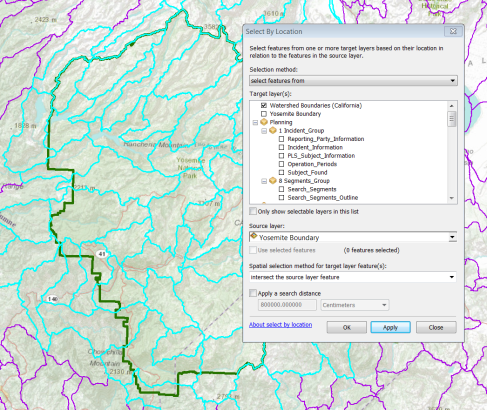The Task Assignment, or Field Map is an essential element for search teams going into the field in response to search and rescue operations. These maps provide assistance with team navigation as well as the ability to communicate certain attributes about specific location (e.g. the position of a clue).
Although these maps play a critical role in team safety and search effectiveness, there doesn't appear to be a documented effort at standardizing the basic layout and the information contained in the map. ASTM standards F 1846 and F 2099 have provided guidelines for map symbology and the use of UTM grids, respectively, but these standards stop short of suggested critical information that should be presented on the map itself. In addition, with the adoption of US National Grid as a standard for all Public Safety agencies in the United States you will need to make some modifications to your old UTM/lat long habits soon. For a dynamic USNG overlay you can use web services found on ArcGIS Online or check out the ArcGIS Desktop Help documentation: Adding an MGRS and U.S. National Grid.
What about basemaps? What should we use? The USGS 1:24,000 topographical map has long been the de facto standard map used by wilderness SAR teams in the United States as these maps have provided basic information on geographic features to assist with navigation. These can also be found on ArcGIS Online or downloaded from most State GIS Portals for free. Given the familiarity of SAR personnel with the format of the USGS topo map, teams often settle on a layout similar to that of the USGS maps with information limited to this basemap. While this may have been adequate for keeping teams safe in the field it may not provide sufficient information for emergency response and effective search operation. In addition, most of the maps are now out of date or will not feature recent hazards.
In today's world of digital mapping we now have the ability to not only create our own map templates for populating broader information but we can also create our own maps combining up-to-date geospatial information with various types of basemaps (imagery, topography, streetmaps, etc). This not only supports a greater situational awareness for the teams in the field but also critical connectivity between field operations and overall search management.
Finally, what else do we need to have on an assignment map? Although during a search operation maps may be created for a variety of needs, we focus here on field maps that accompany task assignments. These maps must clearly communicate the task assignment as well as provide detailed information regarding travel routes and navigational aides, hazards and position. In building a basic field map, we can consider both required elements and optional elements:
Basemap: Topographic map, Imagery with other data, Streetmap, etc. Keep in mind how the map will look when printed in black and white just in case you need to make photocopies. Remember, imagery alone IS NOT A MAP.
Grid: Lat-Long, UTM, US National Grid or some combination.
Map Elements (S.T.A.N.D.D.):
- Scale: Responders need to be able to relate distances and size on the map to the real world. If the map is “not to scale” then write that on the map. Be careful as map scale may change with copying process.
- Title: The title should actually include various information including: Incident name, Incident Number, Map Name and Task Assignment Number. Assignment number also provides a link to the Operational Period for the assignment.
- Author: The person and agency that created the map.
- North Arrow: This should always be on the map. Since the maps may also be used for navigation by compass you should also include reference to Magnetic Declination.
- Date: The date and time information gathered should be written somewhere on the map.
- Datum: The datum of the coordinates on the map This is important information for relaying coordinates and for GPS use.
Command points / ICS Features: Initial Planning Point, ICP, Radio Relays, etc
Legend: Especially, if non-standard symbols are used.
Task Assignment: This should be clearly indicated on the map.
You can also take a look at the GIS Standard Operation Procedures for more insight. We'd love to see some examples of your assignment maps and share what others are doing with the SARGIS community. So send us your maps and let us know if you have any questions.


